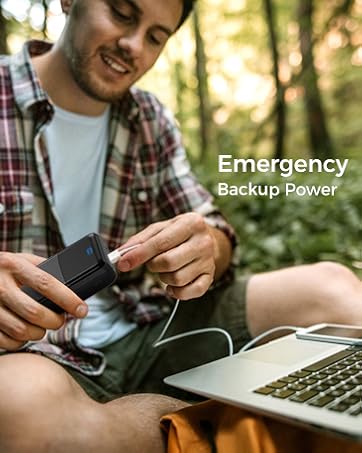Power banks, also known as portable chargers or battery packs, are essential accessories for anyone using cordless electric tools. These compact devices provide a convenient and reliable source of power, allowing you to extend the runtime of your tools and work uninterrupted, even in locations without access to electrical outlets.
In today’s world, where mobility and efficiency are paramount, power banks have become indispensable for professionals and DIY enthusiasts alike. Whether you’re a contractor working on a construction site, a landscaper maintaining outdoor spaces, or a homeowner tackling weekend projects, having a power bank can make a significant difference in your productivity and convenience.
This comprehensive guide will explore the world of power banks for electric tools, covering everything from their types and functionalities to choosing the right one for your needs. We’ll delve into the intricacies of power bank capacity, runtime, and safety considerations, as well as provide insights into the latest trends and innovations in this rapidly evolving field.
Table of Contents
Types of Power Banks for Electric Tools
Power banks for electric tools come in various types based on their capacity, size, and compatibility with different tools. Here are some common types:
High-Capacity Power Banks: These power banks typically have a capacity ranging from 20,000mAh to 50,000mAh or higher. They are designed to provide extended runtime for power-hungry tools like cordless drills, saws, and grinders. These power banks are often larger and heavier but offer longer battery life.
Compact Power Banks: Designed for portability, compact power banks have a capacity between 5,000mAh and 20,000mAh. They are smaller and lighter, making them ideal for powering smaller tools like screwdrivers, flashlights, and portable fans. These power banks strike a balance between capacity and portability.
Tool-Specific Power Banks: Some power bank manufacturers offer models specifically designed for certain electric tool brands or models. These power banks are optimized for compatibility, ensuring seamless integration and efficient power delivery to the specific tools.
Multi-Port Power Banks: These power banks feature multiple USB ports, allowing you to charge multiple tools or devices simultaneously. They are convenient for job sites or situations where you need to power multiple tools or devices at once.
Solar-Powered Power Banks: For outdoor use or remote locations without access to power outlets, solar-powered power banks can be recharged using solar energy. They typically have built-in solar panels or can be connected to external solar panels, providing a sustainable and eco-friendly power solution.
Quick-Charge Power Banks: Featuring advanced charging technologies like Power Delivery (PD) or Qualcomm Quick Charge, these power banks can rapidly charge compatible tools and devices, reducing downtime and increasing productivity.
When choosing a power bank for your electric tools, consider factors such as tool compatibility, required capacity, portability needs, and charging speed to ensure you select the most suitable option for your specific requirements.

How Power Banks Work
Power banks are portable battery packs designed to provide a reliable and convenient source of power for various electronic devices, including electric tools. At their core, power banks rely on rechargeable battery cells, typically lithium-ion or lithium-polymer batteries, to store electrical energy.
Explanation of the Working Principle
A power bank works on the principle of storing electrical energy in its rechargeable battery cells when connected to a power source, such as a wall outlet or a computer’s USB port. Once charged, the power bank can then discharge this stored energy to power or recharge other devices through its output ports (typically USB or DC outputs).
Charging and Discharging Process
The charging process involves converting the alternating current (AC) from a wall outlet or the direct current (DC) from a USB port into the appropriate voltage and current required to charge the power bank’s battery cells. This is accomplished through a built-in charging circuit that regulates the charging process.
When discharging, the power bank converts the stored energy from its battery cells into the appropriate voltage and current required by the connected device. This conversion is handled by a discharging circuit, which ensures that the power output meets the device’s requirements.
Safety Features
Power banks incorporate various safety features to protect both the power bank and the connected devices. These features may include:
- Overcharge Protection: Prevents the battery cells from being overcharged, which can lead to degradation or potential safety hazards.
- Overcurrent Protection: Limits the output current to prevent excessive power draw, which could damage the connected device or the power bank itself.
- Short-Circuit Protection: Automatically cuts off the power supply in the event of a short circuit, preventing potential hazards.
- Overheating Protection: Monitors the temperature and stops charging or discharging if the power bank becomes too hot, reducing the risk of thermal issues.
These safety features are typically implemented through specialized integrated circuits or microcontrollers within the power bank’s circuitry.

Choosing the Right Power Bank
Selecting the right power bank for your electric tools is crucial to ensure optimal performance and convenience. Here are some key factors to consider:
Voltage Compatibility: Electric tools operate at specific voltages, typically ranging from 12V to 20V. Ensure that the power bank’s output voltage matches your tool’s voltage requirements. Using an incompatible power bank can damage your tools or cause safety hazards.
Battery Capacity: Power bank capacity is measured in milliamp-hours (mAh) or watt-hours (Wh). A higher capacity means longer runtime for your tools. Consider the runtime you need and choose a power bank with sufficient capacity. Keep in mind that higher capacity often translates to larger and heavier units.
Output Power: In addition to voltage, check the power bank’s output power, measured in watts (W) or amps (A). Electric tools may require a certain level of power to operate efficiently. Ensure that the power bank can provide the necessary output power for your specific tools.
Portability: If you plan to use the power bank on job sites or in remote locations, consider its portability. Look for compact and lightweight options that are easy to carry around. Some power banks even come with built-in handles or straps for added convenience.
Charging Speed: Evaluate the power bank’s charging speed, especially if you plan to use it frequently. Faster charging speeds can minimize downtime and keep your tools operational for longer periods.
Safety Features: Look for power banks with built-in safety features like overcharge protection, short-circuit prevention, and temperature control. These features help prevent damage to your tools and ensure safe operation.
Brand Reputation: Research and choose power banks from reputable brands known for their quality and reliability. Established brands often offer better customer support and warranty options.
By considering these factors, you can select a power bank that meets your specific needs and ensures optimal performance for your electric tools.
Top Power Bank Brands and Models
When it comes to power banks for electric tools, there are several reputable brands that offer reliable and high-performance options. Here’s an overview of some of the top brands and their popular models:
DeWalt
DeWalt is a well-known and trusted name in the power tool industry, and their power banks are no exception. One of their top models is the DeWalt DCB1800B 20V MAX 8.0Ah Lithium-Ion Battery Pack. This power bank is compatible with a wide range of DeWalt 20V MAX tools and provides extended runtime for cordless tools. It features a robust design and is built to withstand harsh jobsite conditions.
Milwaukee
Milwaukee is another leading brand in the power tool market, and their power banks are designed for professionals. The Milwaukee M18 18V 9.0Ah REDLITHIUM XC Extended Capacity Battery Pack is a popular choice. It offers up to 5 times more runtime than standard battery packs and is compatible with Milwaukee’s M18 cordless tool lineup.
Makita
Makita is known for its high-quality power tools and accessories, including power banks. The Makita BL1860B 18V LXT Lithium-Ion 6.0Ah Battery is a reliable option that provides ample runtime for Makita’s 18V LXT cordless tools. It features a built-in LED battery charge level indicator and is designed for durability.
Bosch
Bosch is a respected brand in the power tool industry, and their power banks are no exception. The Bosch BAT622 18V Lithium-Ion 6.0Ah Slim Battery Pack is a compact and lightweight option that offers extended runtime for Bosch’s 18V cordless tools. It features a fuel gauge to monitor battery charge levels and is designed for optimal performance.
Ryobi
Ryobi is a popular brand among DIYers and homeowners, offering affordable and reliable power tools and accessories. The Ryobi OP4026 18V ONE+ 4.0Ah Lithium-Ion Battery is a cost-effective power bank option that is compatible with Ryobi’s ONE+ cordless tool system. It provides sufficient runtime for most DIY projects and household tasks.
When choosing a power bank for your electric tools, consider factors such as compatibility with your existing tools, runtime requirements, and overall build quality. Reputable brands like DeWalt, Milwaukee, Makita, Bosch, and Ryobi offer reliable options that cater to different user needs and budgets.
Power Bank Capacity and Runtime
The capacity of a power bank is measured in milliamp-hours (mAh) or watt-hours (Wh), and it directly correlates to the runtime you can expect from your electric tools. A higher capacity means more stored energy, allowing your tools to run for longer periods before needing to recharge.
For example, a typical cordless drill might have a battery capacity of 1,500 mAh. If the power bank you’re using has a capacity of 20,000 mAh, you could potentially recharge that drill battery over 13 times before depleting the power bank. However, it’s important to note that factors like the tool’s power consumption and the power bank’s efficiency will affect the actual runtime.
When choosing a power bank for your electric tools, consider the capacity you’ll need based on the tools you plan to use and their typical runtime. A higher capacity power bank may be bulkier and more expensive, but it can provide extended usage in situations where you don’t have access to a power outlet for an extended period.
For example, if you’re a contractor working on a remote job site, a power bank with a capacity of 50,000 mAh or higher could keep your essential tools running for an entire workday or even multiple days, depending on your power consumption needs.
It’s also worth noting that power bank capacity is not the only factor that determines runtime. The output voltage and current capabilities of the power bank must match the requirements of your electric tools. Most power banks are designed to work with a wide range of devices, but it’s always a good idea to check the specifications to ensure compatibility.
Safety Considerations
Safety should be the top priority when using power banks for electric tools. These devices store a significant amount of electrical energy, and improper handling or usage can lead to hazardous situations. It’s crucial to follow the manufacturer’s instructions and take necessary precautions to ensure safe operation.
Firstly, it’s essential to use power banks specifically designed for electric tools. These power banks are built to handle the high current draw required by power tools, unlike regular consumer power banks intended for charging smartphones or tablets. Using an incompatible power bank can result in overheating, damage to the device, or even fire hazards.
Proper handling and storage of power banks are equally important. Avoid dropping, puncturing, or exposing the power bank to extreme temperatures, as this can compromise the internal battery cells and increase the risk of fire or explosion. Always store power banks in a cool, dry place, away from direct sunlight or heat sources.
Fire hazards are a significant concern when dealing with power banks. Lithium-ion batteries, commonly used in power banks, can ignite if damaged or subjected to excessive heat or short-circuiting. Never attempt to disassemble or modify a power bank, as this can lead to internal damage and increase the risk of fire. If you notice any signs of swelling, leakage, or overheating, immediately discontinue use and follow the manufacturer’s guidelines for disposal or replacement.
It’s also crucial to use the power bank within its specified voltage and current limits. Overloading the power bank by connecting too many tools or devices can cause overheating and potentially lead to fire or damage. Always check the power bank’s specifications and ensure that it can safely handle the combined power requirements of your electric tools.
In case of any incidents involving fire or smoke, act quickly and follow proper safety protocols. Keep a fire extinguisher nearby and be prepared to evacuate the area if necessary. Additionally, seek professional assistance if you encounter any issues or have concerns about the safe operation of your power bank.
By adhering to these safety guidelines and exercising caution, you can minimize the risks associated with using power banks for electric tools and enjoy the convenience and portability they offer.
Power Bank Maintenance and Care
Proper maintenance and care are crucial for ensuring your power bank delivers optimal performance and has a long lifespan. Here are some tips to help you get the most out of your power bank:
Charging Best Practices
- Use the manufacturer-recommended charger and cable for charging your power bank.
- Avoid overcharging the power bank, as this can degrade the battery over time.
- Let the power bank cool down before charging if it’s hot from extensive use.
Storage Guidelines
- Store your power bank in a cool, dry place when not in use.
- Avoid exposing the power bank to extreme temperatures, as this can damage the battery.
- Ideally, store the power bank with a partial charge (around 50%) to prolong battery life.
Battery Maintenance
- Perform periodic full discharge and recharge cycles to calibrate the battery and maintain accuracy in charge level indicators.
- Avoid deep discharges (below 20%) as much as possible, as this can strain the battery.
- Replace the power bank if you notice significant capacity loss or swelling, as this could indicate a damaged battery.
General Care
- Keep the power bank clean and free from dust and debris, as these can interfere with charging ports and ventilation.
- Avoid dropping or subjecting the power bank to physical shocks, as this can damage internal components.
- If the power bank gets wet, dry it thoroughly before attempting to use or charge it.
By following these maintenance and care tips, you can extend the lifespan of your power bank and ensure it remains a reliable source of power for your electric tools and other devices.
Cost and Value Considerations
The cost of a power bank for electric tools can vary significantly depending on several factors. Generally, higher capacity power banks with advanced features tend to be more expensive. However, it’s essential to consider the long-term value and cost-effectiveness of a power bank, rather than just the upfront cost.
One of the primary factors affecting the price is the battery capacity, measured in milliamp-hours (mAh) or watt-hours (Wh). Higher-capacity power banks can charge multiple tools or provide extended runtime, but they also come with a higher price tag. Typical capacity ranges from 10,000 mAh to 50,000 mAh or higher, with prices ranging from $30 to $200 or more.
Another factor influencing cost is the power output, measured in volts (V) and amps (A). Power banks with higher output capabilities, such as those designed for high-demand tools like circular saws or grinders, tend to be more expensive due to the advanced circuitry and components required.
Brand reputation and additional features like fast charging, multiple output ports, rugged construction, and solar charging capabilities can also drive up the cost of a power bank.
While a higher upfront cost may seem daunting, it’s essential to consider the long-term value and cost-effectiveness of a power bank. A high-quality, high-capacity power bank can potentially save you money in the long run by reducing the need for frequent battery replacements or downtime due to uncharged tools. Additionally, a well-built power bank can last for several years, providing a better return on investment compared to cheaper, lower-quality options.
When evaluating the cost and value of a power bank, consider factors such as the types of tools you use, the frequency of use, and the importance of portability and runtime. A higher-priced power bank may be a worthwhile investment for professionals or those who rely heavily on their electric tools, while a more budget-friendly option may suffice for occasional or light use.
Use Cases and Applications
Power banks for electric tools offer a convenient and portable power solution for various applications, enabling users to work efficiently in locations where access to traditional power sources is limited or unavailable. Here are some practical examples and benefits of using power banks with electric tools:
Construction and Renovation Sites: Worksites often lack readily available power outlets, making power banks invaluable for powering tools like cordless drills, saws, and nailers. This allows for uninterrupted work without the hassle of running extension cords or relying on gasoline-powered generators.
Outdoor Projects: Landscaping, gardening, and outdoor maintenance tasks often require the use of electric tools away from power sources. Power banks provide the necessary juice to keep tools like hedge trimmers, blowers, and chainsaws running, enabling you to complete projects without interruptions.
Emergency and Disaster Response: In situations where power outages occur due to natural disasters or other emergencies, power banks can be a lifesaver for powering essential tools needed for rescue operations, debris removal, or temporary repairs.
Remote Locations: For professionals working in remote areas, such as forestry workers, archaeologists, or field researchers, power banks offer a reliable source of power for tools like cordless saws, drills, and other equipment, ensuring productivity in off-grid environments.
DIY and Hobby Projects: Whether you’re a woodworker, crafter, or hobbyist, power banks allow you to use your electric tools anywhere, from the garage to the backyard, without being tethered to a power outlet.
Camping and Outdoor Adventures: Outdoor enthusiasts can benefit from power banks by keeping essential tools like portable saws, inflators, or lighting devices charged during camping trips or other outdoor activities.
Using power banks with electric tools not only provides convenience and mobility but also enhances productivity, safety, and efficiency in various scenarios where access to traditional power sources is limited or non-existent.
Future Trends and Innovations
The world of power banks for electric tools is rapidly evolving, driven by advancements in battery technology and a growing demand for more efficient and eco-friendly solutions. One of the most promising trends is the integration of renewable energy sources, such as solar panels, into power bank designs. This innovative approach not only reduces the reliance on traditional power sources but also promotes sustainability in the construction industry.
Another exciting development is the emergence of wireless charging capabilities for power banks. This technology eliminates the need for cumbersome cables and allows for seamless charging of multiple tools simultaneously, increasing productivity and convenience on job sites.
Furthermore, researchers are exploring the potential of using graphene and other advanced materials in battery construction, which could lead to power banks with significantly higher energy densities and faster charging times. These advancements could revolutionize the way professionals work, enabling them to tackle more extensive projects without worrying about power limitations.
In addition to technological advancements, manufacturers are also focusing on improving the ergonomics and portability of power banks. Compact and lightweight designs, combined with features like rugged construction and water resistance, will make these devices more versatile and suitable for various job site conditions.
As the demand for sustainable and efficient energy solutions continues to grow, it is likely that power banks for electric tools will become an integral part of the construction industry’s efforts to reduce its carbon footprint and embrace eco-friendly practices.
Frequently Asked Questions
Q: What types of electric tools can be powered by a power bank?
Power banks are commonly used to charge cordless power tools like drills, saws, sanders, and trimmers. They can provide extended runtime for tools with removable battery packs, allowing you to work for longer periods without access to a power outlet.
Q: How long will a power bank run my electric tool?
The runtime depends on the power bank’s capacity and the tool’s power requirements. Higher capacity power banks (measured in milliamp-hours or mAh) will run tools for longer periods. Additionally, tools with more efficient brushless motors or lower voltage requirements will drain the power bank more slowly.
Q: Can I charge my power bank and use it simultaneously?
Most power banks cannot be charged and discharged at the same time. It’s generally recommended to fully charge the power bank before use and then recharge it after it’s depleted. Using it while charging can damage the battery or cause overheating.
Q: How do I know if my power bank is compatible with my tool?
Check the voltage and amperage requirements of your tool’s battery pack. The power bank should have an output voltage that matches the tool’s battery voltage (typically 18V, 20V, etc.). The amperage output should also meet or exceed the tool’s requirements for optimal performance.
Q: How long do power banks last before needing replacement?
Power bank lifespan depends on usage patterns and charging habits. Most quality power banks can withstand 300-500 charge cycles before experiencing significant capacity loss. Proper care, such as avoiding excessive heat or complete draining, can extend their lifespan.
Conclusion
Power banks have become an essential accessory for anyone working with cordless electric tools. They offer a convenient and reliable way to extend the runtime of your tools, allowing you to work uninterrupted for longer periods. By understanding the key factors, such as capacity, output power, and safety features, you can choose the right power bank that meets your specific needs.
As the demand for portable power solutions continues to grow, we can expect to see further advancements in power bank technology. This may include higher capacities, faster charging speeds, and improved energy efficiency. Additionally, the integration of smart features, such as battery management systems and wireless charging capabilities, could enhance the overall user experience.
When selecting a power bank for your electric tools, consider factors like the required voltage, amperage, and runtime for your specific tools. Look for reputable brands that prioritize safety and offer robust construction. Proper maintenance, including regular charging and storage practices, will help ensure the longevity of your power bank.
Investing in a high-quality power bank can be a game-changer for professionals and DIY enthusiasts alike. It not only enhances productivity by eliminating downtime but also offers the flexibility to work in remote locations without access to power outlets. With the right power bank, you can tackle even the most demanding projects with confidence and efficiency.



